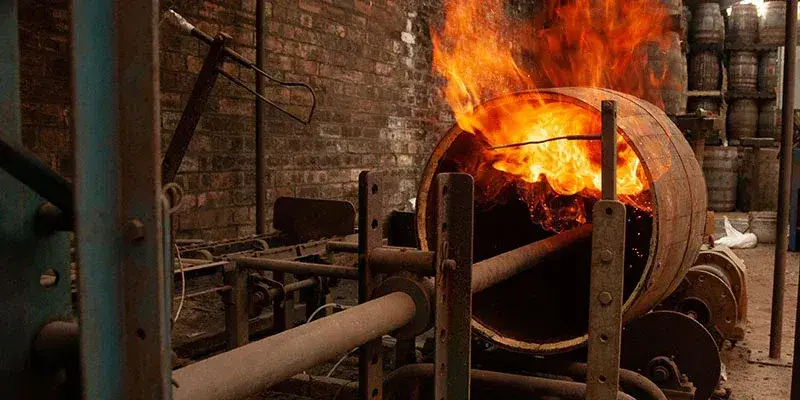The Science of the Sip: How Barrel Char Levels Transform Flavor
The amber liquid that flows from a freshly opened bottle of whiskey carries with it a complex symphony of flavors, many of which owe their existence to a seemingly simple process: charring the inside of oak barrels. This ancient practice, refined over centuries of distilling tradition, represents one of the most fascinating intersections of chemistry, craftsmanship, and culinary science in the spirits world.
The Alchemy of Fire and Wood

When coopers char the interior of oak barrels, they’re conducting a controlled pyrolysis reaction that fundamentally alters the wood’s chemical structure. The intense heat breaks down complex compounds in the oak, creating new molecules that will later migrate into the aging spirit. This process occurs at temperatures reaching 500-600°F, hot enough to transform but not destroy the wood’s essential character.
The char acts as both a gateway and a filter. As spirits expand and contract with temperature changes, they penetrate deeper into the wood through the char layer, extracting compounds that would otherwise remain locked within the oak’s cellular structure. Simultaneously, the char serves as a natural filtration system, removing harsh compounds while allowing desirable flavors to develop.
Understanding Char Levels
Distilleries typically employ four standardized char levels, each creating distinct flavor profiles through varying degrees of wood transformation. A Level 1 char, known as a “light char,” involves just 15 seconds of flame contact. This gentle treatment creates minimal carbonization while opening the wood’s pores just enough to allow spirit penetration. The result is subtle wood influence with delicate vanilla and honey notes.
Level 2 chars extend the flame exposure to 30 seconds, creating deeper penetration zones and more pronounced caramelization of the wood’s natural sugars. This moderate char level produces balanced vanilla and spice characteristics that form the backbone of many classic bourbon profiles.
The 45-second Level 3 char represents the sweet spot for many distillers. This “medium char” creates optimal conditions for extracting vanillin, the compound responsible for vanilla flavors, while developing enough caramelization to contribute rich butterscotch and toffee notes. The char layer becomes thick enough to provide significant filtration while maintaining efficient spirit-wood interaction.
Level 4, the “alligator char,” subjects barrel interiors to 55 seconds of intense flame. The resulting char layer cracks and buckles, resembling alligator skin and creating maximum surface area for spirit contact. This heavy char produces the most dramatic flavor transformation, yielding intense vanilla, rich caramel, and pronounced spice notes, though it can overwhelm delicate spirits if not carefully managed.
The Chemical Ballet
The charring process triggers a cascade of chemical reactions that continue throughout the aging process. Lignin, one of wood’s primary structural components, breaks down under heat to form vanillin and other aldehydes that contribute vanilla, almond, and fruity notes. The higher the char level, the more lignin degrades, intensifying these flavors.
Cellulose and hemicellulose also undergo transformation during charring. These compounds break down into simple sugars that caramelize, creating the brown color compounds known as melanoidins. These contribute not only to the spirit’s eventual amber hue but also to its mouthfeel and sweet, caramel-like flavors.
The char layer itself becomes a reactive surface where ongoing chemical reactions occur throughout aging. Tannins from the wood interact with alcohol and other compounds in the spirit, creating complex esters and acetals that contribute fruity and floral notes. Meanwhile, the char’s carbon structure acts like activated charcoal, removing sulfur compounds and other harsh elements that could create off-flavors.
Beyond the Char: Environmental Factors
While char level significantly influences flavor development, it works in concert with numerous other variables. Climate plays a crucial role, as temperature fluctuations drive the spirit in and out of the wood. Warehouses in Kentucky experience dramatic seasonal variations that accelerate this process, while Scottish distilleries’ more stable temperatures create gentler, more gradual flavor development.
Humidity affects evaporation rates and concentration, while air pressure changes can influence the rate at which spirits penetrate the char layer. Even the barrel’s position within the warehouse matters, as upper floors experience greater temperature variations than lower levels, leading to more intense flavor extraction.
The Master’s Touch
Experienced distillers understand that char level selection requires balancing the base spirit’s character with desired flavor outcomes. A delicate grain whiskey might be overwhelmed by Level 4 char, while a robust rye mash bill could benefit from the intense vanilla and spice extraction that heavy char provides.
Some distilleries experiment with custom char levels or even double-charring techniques, where barrels receive an initial char, then age spirits before being re-charred and refilled. These innovative approaches demonstrate how traditional processes can evolve while maintaining their fundamental scientific principles.
The Future of Char Science
Modern distillers increasingly rely on analytical chemistry to understand and optimize char effects. Gas chromatography reveals the precise compounds extracted at different char levels, while spectroscopy helps track flavor development throughout aging. This scientific approach doesn’t replace traditional tasting and experience but enhances distillers’ ability to achieve consistent, exceptional results.
Some innovative producers explore alternative wood species and even different burning techniques, using controlled atmospheres or varying flame temperatures to create unique char characteristics. These experiments push the boundaries of traditional charring while respecting the fundamental chemistry that makes the process work.
The next time you savor a glass of aged whiskey, consider the remarkable transformation that began with fire and wood. That complex interplay of vanilla sweetness, caramel richness, and spicy warmth represents centuries of accumulated knowledge about how controlled combustion can unlock oak’s hidden flavors. In every sip lies the evidence of a process that remains both ancient craft and modern science, where the marriage of flame and wood creates liquid poetry in a glass.
The char level may seem like a simple specification, but it represents one of the most powerful tools in a distiller’s arsenal for shaping flavor. Understanding this process deepens appreciation for the craft and science behind every exceptional aged spirit, revealing how tradition and innovation continue to evolve in perfect harmony.
